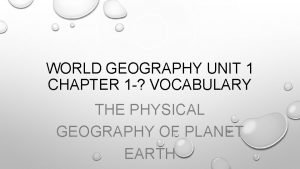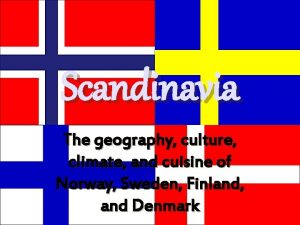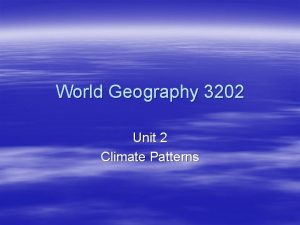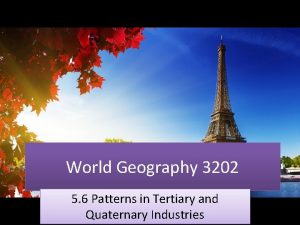World Geography 3202 Unit 2 Climate Patterns The








- Slides: 8

World Geography 3202 Unit 2 Climate Patterns

The relationship between elevation and climate • Elevation is defined as height of sea level. • The relationship between climate and elevation is defined by the fact that the higher the elevation, the colder the air temperature. • Mountain climates tend to be colder than their lower elevation counterparts, regardless of latitude. • Mountains can also affect precipitation as we previously saw through the effects of orographic precipiation.

The combined effect of climatic conditions and the zones they produce • Tropical climates: • Warm temperatures all year round • Two distinct patterns of precipitation • One where heavy rainfall occurs all year long (Ie: Rainforests) • One where there is a marked difference between a wet and dry season (Monsoons)

The combined effect of climatic conditions and the zones they produce • Dry Climates: Are set apart by the extremely small amount of precipitation they receive. • They include arid or desert regions, found in latitudes between 10 and 30 degrees north and south of the equator • It also includes Steppe or Grassland regions.

The combined effect of climatic conditions and the zones they produce • Temperate Mild winter climates: Are exactly as they sound: Mild winters and warm to hot summers. • Found in middle latitudes with sea or ocean coasts.

The combined effect of climatic conditions and the zones they produce • Temperate Cold Winter Climates: Moving farther north from the equator, in areas such as Canada, the mid-western and northern US, and much of Northern Asia, the regions experience notable differences in seasons as experienced through temperatures. • The range between winter and summer temperatures is great • Summer days are extremely long and hot in the continental interiors • The further north you go, the colder it gets • Extremely long and cold winters

The combined effect of climatic conditions and the zones they produce • Polar climates: Because they receive such little direct sunlight, they are cold all year round. • In addition, the sun may not shine for months at a time in the winter.

The combined effect of climatic conditions and the zones they produce • Highland Climates: Are chiefly characterized by the elevation they are associated with and thus tend to be colder.















